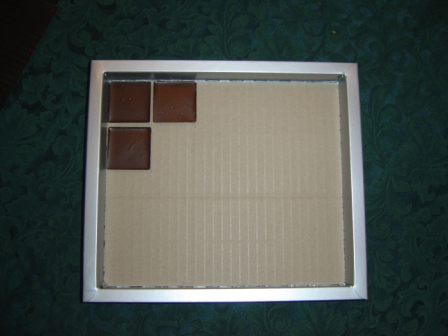Better Multiplication Strategies: 2.75
Supporting materials
- Related Progression Points
- Developmental Overview of Methods of Calculation (PDF - 38Kb)
- Developmental Overview of Proportional Reasoning and Multiplicative Thinking (PDF - 41Kb)
Indicator of Progress
Students can solve multiplication problems by using a multiplicative strategy (repeated addition or multiplication facts) to work out the answer rather than counting out objects in ones. They recognise an array as modelling a multiplication situation and they can work with unseen items in groups or arrays.
Some students continue to use inefficient strategies, especially counting by ones, and as a consequence cannot deal with unseen items. We need to encourage students to use more efficient strategies that relate to the multiplicative structure.
Click here to find out more about multiplication.
Illustration 1: Calculating with unseen groups
Illustration 2: Calculating with unseen objects
Students who only use a count by ones strategy will struggle with the following task:
Show 5 brown paper bags. Tell the students that each bag has 4 lollies inside and ask: "How many lollies are there altogether?"
In this case, the students can see the 5 bags but not the lollies inside. This task encourages students to count by fours rather than by ones.
Illustration 3:

Examples of the types of tasks that would be illustrative of multiplication concepts, aligned from the Mathematics Online Interview:
- Question 27 - Place 2 teddies in four cars and say how many there are altogether - using skip counting strategies
- Question 28 - Share 12 teddies equally into 4 groups
- Question 29 - How many balls would there be in four packets of tennis balls?
- Question 30 - Dots arrays: How many dots are there altogether on the whole card?
Teaching Strategies
These activities are designed to encourage students to calculate the answer without having to model the problem with concrete materials or draw a picture of all the items. Students may use different strategies for each of these activities. Discuss the various strategies, emphasising ways that students work out the total without having to draw all of the items. This is one way in which students can be moved away from count-by-ones methods.
Activity 1: How many chocolates?, uses a model but with key elements missing.
Activity 2: Partially covered arrays, poses a problem where some of the items to be calculated are hidden. The numbers of rows and columns can be deduced.
Activity 1: How many chocolates?
Pose this problem to the students:
You have found that the box of chocolates you were given has only a few chocolates left. How many chocolates did it have to start with? Write a story to explain how you worked out the answer.
 |
This activity requires the students to think about the pattern the chocolates made in the box. Encourage students to look for array structure (eg, how many in each row, how many rows).
What if we had a larger box? How many chocolates would there be if there were 12 rows of 8 chocolates? How did you work it out?
Activity 2: Partially covered arrays
This is both an instructional activity and an assessment activity for identifying students' understanding of how multiplication links with arrays.
An array of dots is quickly shown to a student. The student should have long enough to see that the dots is a complete array, but not long enough to count the dimensions. Quickly, a sheet of paper is placed on top of a set of dots and this is placed in front of the student. How many dots are there altogether on the paper?
Students who understand the structure of an array and how that corresponds to multiplication, or to equal groups, will look at the number of rows and the number of columns. They may calculate the answer in various ways: automatic recall of the number fact (i.e. 4 × 7 or 7 × 4 for the diagram below), repeated addition (i.e. 7 + 7 + 7 + 7 or 4 + 4 + 4 + 4 + 4 + 4 + 4) or in another way.
Instructional activity
Start with a small number of dots covered by a piece of paper. Discuss with students the strategies they could use to determine the number of dots. Some will first want to find the number that are covered. Be sure that students can follow the row and column structure to locate which dots would be missing. Encourage students to work out how many dots are covered without counting them one by one, or drawing them on the page. Encourage them to count how many are in each row, and work out how many rows. It is acceptable to solve this using repeated addition.
Once students are confident working out small numbers of dots that have been covered increase the number of dots.
|
|
|
Further Resources
The following resource contains sections that may be useful when designing learning experiences:
Digilearn object *
The array – students use an array-building tool to help solve multiplications. Students learn strategies to break up multiplications. Students create and solve easy multiplications, eg 9x3. Students learn relationships between rows, columns and areas in arrays.
(https://www.eduweb.vic.gov.au/dlr/_layouts/dlr/Details.aspx?ID=4908)
Pobble arrays: find a factor – students help creatures to line up and walk through gates. Students make equal rows and columns. For example, predict how many equal rows of pobbles are needed to fit 12 of them through four gates. Students check their prediction.
(https://www.eduweb.vic.gov.au/dlr/_layouts/dlr/Details.aspx?ID=4496)
Arrays: worded problems with products from 10 to 30 – students read a number problem and think about how to solve it. For example, when 13 is divided by a number, the answer is 6 with a remainder of 1. Students write the problem as a multiplication or division number sentence with a missing number. Students think about multiplication or division facts to find the missing number. Students test their answer by making an array of equal rows and columns to show the multiplication or division fact and the remainder.
(https://www.eduweb.vic.gov.au/dlr/_layouts/dlr/Details.aspx?ID=4499)
* Note that Digilearn is a secure site; SMART::tests login required.


